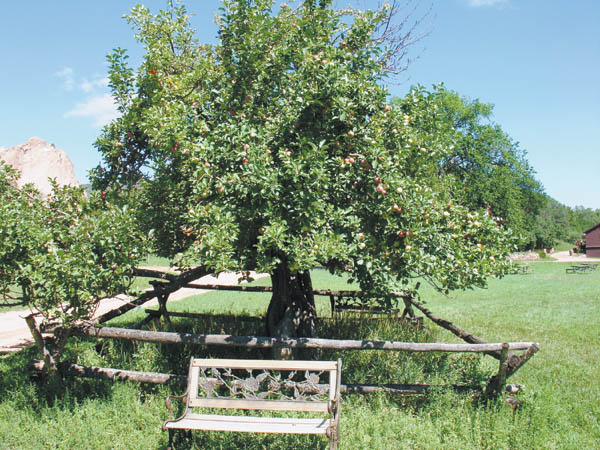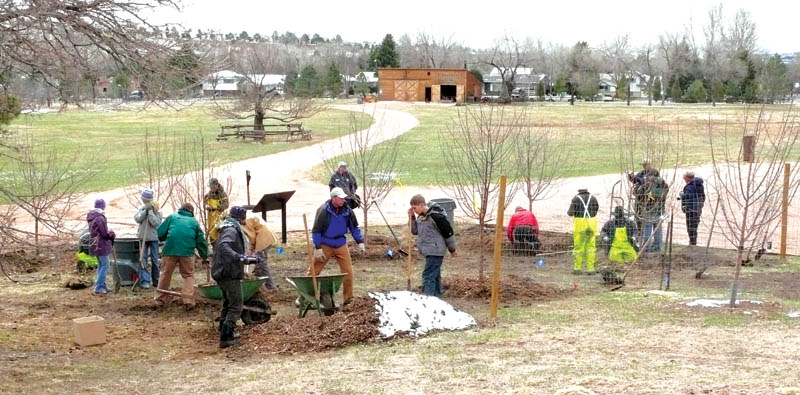 One of two baby trees that were cloned from its cuttings. Westside Pioneer photo
|
Most visitors to the Rock Ledge Ranch Historic Site know it as that gnarly old apple tree sitting by itself with a hole in its trunk big enough to pass a picnic basket through.
 The old tree at the Rock Ledge Ranch Historic Site, which was planted in the late 1800s, is shown laden with apples in a recent year. Courtesy of Andy Morris
|
The view inspired Kircher, a long-time area artist, to paint a watercolor this spring entitled “Old Rosy,” depicting the still-leafy tree from its east face where the hole is most prominent.
Morris, the ranch manager, said that the “grandaddy” - which still produces apples in years that don't have blossom-time frosts (as happened this year) - is one of the few remaining from the fruit orchards planted in the late 1800s by the Chambers family, who also built the nearby Rock Ledge House. “That tree sits by itself, and it's weathered some big storms,” he said, admiringly.
Now, using modern gardening technology, the ranch is on its way to having two more trees just like it. As in exactly like it. Morris even used the word “clones” when talking about the 6-inch-long, soft-wood cuttings that were taken from the tree's new growth two years ago, then nurtured in a city greenhouse at 100 percent humidity with special hormones on their stems to stimulate root growth. Those cuttings have since taken the form of young trees, nearly 3 feet tall, planted in a grassy area and protected by 4-foot-high chicken wire, off to the side of the city-owned Patty Jewett golf course property.
 Volunteers join city staffers in planting new apple trees at Rock Ledge during the 2009 Earth Day. In the background can be seen the old tree, standing by itself. Westside Pioneer photo
|
The plan is to transplant them back to Rock Ledge in about three years, when they should be about 8 feet tall and their trunks 1 ˝ inches in diameter, explained Paul Smith, the head of the city's Forestry Division.
Donna Sanchez, a Forestry employee, said the two clone trees are the only ones remaining from more than 100 cuttings that were taken. The poor survival rate was a fluke, she said, resulting from a water supply issue, and the city hopes to try more cuttings this year.
The idea of creating new life from the old tree initially was Morris'. Because of the historical upside and potential cost savings, “I've been wanting to do that ever since I started here,” he said.
The rebirth has been heavily supported by the volunteer Broadmoor Garden Club. Vicki Kipp, a club leader, said that over the past several years its members have given Rock Ledge more than 60 trees - most of them planted during Earth Day celebrations when volunteers from the community have joined ranch and city staff in the work. The club's involvement is tied to the 100th anniversary of the Garden Club of America in 2013; its members needed a project for that, and they chose the Rock Ledge orchard. But the group also believes that “trees are an important part of our canopy and our culture,” Kipp said.
Separate from the Patty Jewett clones, the Broadmoor Garden Club has backed a grafting method that also promises to produce trees “related” to Old Rosy. In grafting, a cutting from a tree is combined with root stock from another to produce a new tree. The Garden Club believes that grafting - like cutting/ cloning - will prove to be less expensive in the long run than buying new, mature trees.
 Shirley Kircher’s painting of “Old Rosy.” Westside Pioneer photo
|
Another sameness is that grafting does not produce trees right away. Five grafted creations are growing now at a nursery in northern Colorado; Kipp estimated two years before they will be ready for transplanting to Rock Ledge.
So are the two methods practically alike? Kipp thinks so, but Sanchez and Smith beg to differ. According to Sanchez, “the downfall to grafting is that it's limited to what the root stock is. So it's not a true descendant.” By the same token, Smith noted that a cutting taken from a tree “is 100 percent that tree.”
In any case, Morris is happily anticipating trees from both methods to continue the Chambers orchard lineage. And, with the clone trees, “we'll have a new generation of the same tree - the most famous tree on the ranch,” he enthused.
Smith thinks the preservation efforts are occurring none too soon, considering how old Grandaddy/Rosy is. “It's just a day-to-day thing with that tree,” he said, referring to its mortality. “It's not going to take much.”
Westside Pioneer article